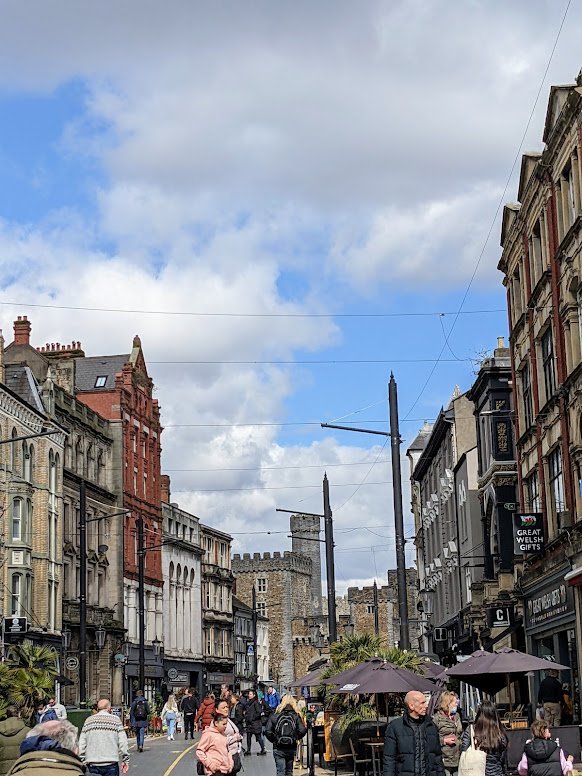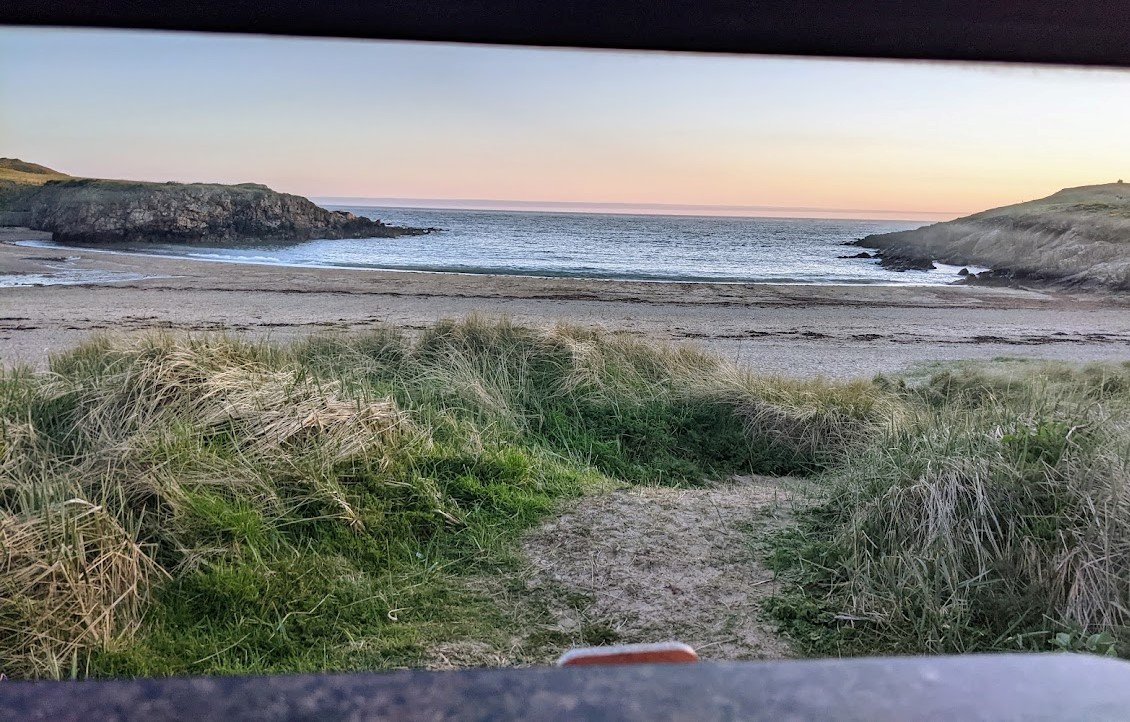Wales
Carreg Cennen Castle
After nine days in Wales we became true fans of the fierce, proud and hospitable people and culture and landscape of this small UK country. With castles populating the skylines, wide open expanses of moors, stone wall lined sheep pastures, and the mountainous Snowdonia country, Wales was a delight to explore.
Our nine day drive across Wales (and using some of the motorway in England)
In our first history lesson we learned that when the Saxons arrived (after the Romans but before the Normans), they successfully pushed the native Britons west and south, basically into Wales. King Offa from Mercia sealed the separation by building a huge dyke between what is now England and Wales in the 700’s AD. Battles ensued back and forth until King Edward I from England finished the conquering, establishing a series of castles in Wales to maintain control and purloined the title “Prince of Wales” to denote the successor to the English throne and the controller of the Welsh territory. (Prior to that the “Prince of Wales” had referred to the largest land owner, or most powerful person in Wales, the default leader.) But the Welsh did not give up fighting back for autonomy and retain a strong sense of national identity today. And though she be but little she is fierce.
The red dragon leads the way! - slogan on the Welsh flag. Grounds of Cardiff castle.
The Celtic Welsh language harks back to the days when the Britons lived in England (before they were pushed out), and there has been a recent resurgence and national effort to popularize it’s use. It is once again taught uniformly in schools and all public signs are in both languages. The one sign we figured out was Dim Parcio. No Parking. We managed to spend our time in Wales without learning how to pronounce anything successfully (there are sounds our aged vocal chords will never learn how to make) and basically butchering place names with our hilarious American accents. One young child told Andy he sounded like Kermit the Frog. Haha.
Tintern Abbey - beautiful abbey ruins on the bank of the river Wye, dating back to 1131.
We hit the ground running, exploring historic sites. We admired the stately ruins and sense of history at Tintern Abbey then made our way to the Caerleon Roman Fortress ruins. Although one of the largest and most important Roman settlements in Britain, we found it more difficult to connect with the history here. Because the original fortress is so large, the excavated sites are spread around the modern village. Our ignorance of the impact of what we were seeing led to a rather lackluster visit for us. If we had taken the time to do more reading and research or booked a tour we likely would have gotten more out of it. But some days we are just tired.
Remains of a Roman ampitheatre at Caerleon
Roman barracks remains - back to being tired, Andy resting
After a restful night we were ready to be inspired again and drove to Caerphilly. The biggest castle in Wales, it is surrounded by an impressive water defense system.
Caerphilly Castle, dating back to 1286
Park4Night continued to be a great resource for us in Wales, but we still had challenges. It is technically not legal to wild camp in Wales, but with discretion you can find places. More so than any other country where we had used the app, there were repeated references to locals being upset with campers parking at roadside spots, parks and laybys. We have sympathy for the concerns so tried to find places that were not populated or more out of the way. We stayed away from any land that looked like it was in active agricultural use (most of Wales).
We also learned a number of new (to us) British terms through Park4Night. At first references to doggers, boy racers and beepers confused us and we ignored them. After some Googling we decided to pay more attention. Fellow campers were sending us huge warnings. The British term dogging means “people engaging in public sex while others watch” WHO KNEW??? This is a popular activity in some out of the way parking area and takes place in cars and vans. Apparently there is not an equivalent term in the US. No comment on what that says about British vs Americans . . Henceforth we avoided sites that were dogging sites. (Originally we had thought it meant dog walkers.) Boy racers are young men who speed up and down country roads in their sports cars and beepers are frustrated locals who purposefully honk late at night or early in the morning to wake up campers. Well armed with more knowledge, we wild camped most of our time in Wales and never had any encounters with any of the above.
Our most urban camping site, spent the night at a small park outside of Caerphilly, we were the only campers there.
Next stop on the Welsh tour, the thriving capital city of Cardiff.
Main pedestrian shopping thoroughfare ending at Cardiff Castle.
Indulged in our favorite big city activity - free city walking tour with our knowledgeable guide Eugene.
Cardiff sports stadium - as we learned the Welsh LOVE rugby. We were regaled with tales of their original singing of the national anthem to a New Zealand team in response to the team performing a Maori Haka dance (so the Welsh started the national anthem tradition!). Soccer(football) is huge too - go Gareth Bale.
Welsh cakes became an immediate favorite for us - soft shortbread with currants, hot off the griddle, so good.
Numerous colorful indoor arcades connect downtown areas of Cardiff - allowing people to navigate the streets without getting wet in the rain.
Norman Keep in the middle of Cardiff Castle.
We left Cardiff and started our way northwest, stopping off at the Gower peninsula on the way for Dawn to visit her relatives.
Newest family members, Dawn’s cousin’s daughter’s daughters (no idea what that means in relations world) Poppy and Lily.
Welsh ponies grazing on Gower Peninsula
Rhossili Bay
Beautiful coastal walk - feeling the Welsh ocean spray
We found that much of the driving in Wales, once you left the main motorways, involved wending your way through small roads and scenic villages with stone houses and slate rooves. With the villages and roads having been built before cars, two way streets were usually only wide enough for one lane of traffic (especially after people parked on one side or the other, in front of their houses or making deliveries) so people courteously waited their turn. The villages were fun to explore, people warm and friendly and each town seemed to have its own hero or villain story with historic signage and public walking paths. Many of these involved the exploits of Owan Glyndwr, the legendary Welsh leader in fighting the English in the 14th century. He had many hide outs, friends and victories across the land.
Camping at Brecon Beacons National Park - one of our favorite places in Wales. Despite the fact that the winds blew so hard that it blew our stairs off. Twice.
We found our happy place in Brecon Beacons with its endless expansive views, beautiful hiking and, of course, castles. Castle Carreg Cennen was one of our favorites, high atop a windswept hill. Although mostly in ruins, you could feel its former grandeur. And of course it was at one point taken control of by Edward I when he made his move to conquer Wales for England, and later the scene of a battle when Owan Glyndwr tried unsuccessfully to take it back for the Welsh.
Castle Carreg Cennen, built over the 12th, 13th and 14th centuries.
Complete with a cave to explore!
Andy feeling the wind as he runs down the hill
Inner courtyard
Beautiful four waterfall hike in Brecon Beacons national park - easy five mile loop.
Endless vistas on top at Brecon Beacons National Park
Ruins of Llanthony Priory in Brecons Beacons. One of our favorite camp spots, paid 5 GBP a person to camp on the grounds.
Field next to Llanthony Priory. So crowded.
Classic country road, one lane, twisty, tall hedges. We rarely even made it up to the speed limit. Don’t know how those boy racers do it.
Roadside camping spot on Park4Night outside Conwy
Walking the medieval town walls at Conwy
Can you find the truck?
Conwy Castle - our favorite in Wales
We visited the series of King Edward’s castles along the northern edge of Wales (Conwy, Beaumaris, Harlech and Caernarfon) and Conwy was by far the most magnificent. We began our visit by walking the medieval town walls and ended by climbing the spiral staircases and battlements of the castle and exploring the king’s residential chambers. Built the late 1200’s, Owain Glyndwr’s agents managed to take charge of it in the early 1400’s, but only briefly.
Satiated with history, we sought out some nature in Snowdonia National Park. Gorgeous mountains (we did not climb Snowdon), lakes, rivers and more historic villages.
Snowdonia National Park - popular, easy 5 mile hiking loop to and around Llyn Idwal.
One of our rare paid campgrounds - 20 GBP for the two of us which is on the lower end of the going rate in Wales. (most of Snowdonia National Park closed to overnight parking We had a, beautiful site at Rynys Camping, a farm in the park with a welcoming owner and beautiful facilities.
Village of Beddgelert in Snowdonia
Our first camper art! Embroidered by our daughter Claire - it makes us smile every day.
Stopped off in Blaenau Ffestiniog - slate mining center in the park. Bought wonderful bread and pasties (pastry pies with meat and or veggies inside) from Model Bakery run by a lovely Kurdish gentleman. Kurdish pasties in a small village in Wales- wow!
Harlech Castle
Morning walk along a public footpath near Caernarfon. Dawn laughing because Andy is having a grumpy morning. It always works best when only one of us is grumpy.
Camping spot on a hill overlooking Harlech. Joined by two vans but no doggers, boy racers or beepers.
Realities of life on the road - rotating the tires at a roadside rest area
Last stop in Wales - the village with the longest name in Europe (second longest place name in the world to a place in New Zealand). This sign has the short version.
And here is the real name
Final night on the northern Welsh coast on the island of Anglesey
View out the back window as we ate dinner
Beautiful morning
Hello Ireland! Ferry from Holyhead.
















































